News Archive
Dan Strom, USTUR
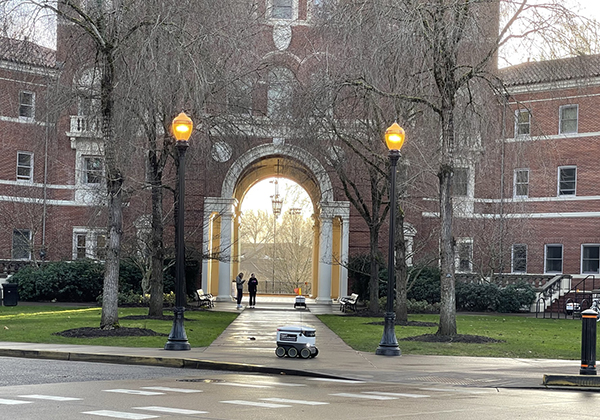
The lovely Oregon State University campus included a fleet of autonomous six-wheeled food-delivery robots!
Photo courtesy of Dan Strom
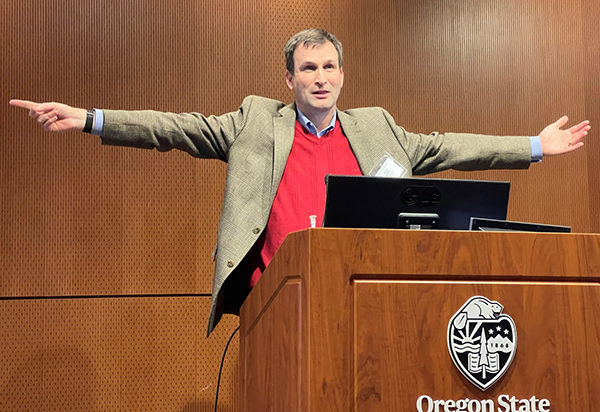
Derek Jokisch explaining specific absorbed fractions
Photo courtesy of Dan Strom
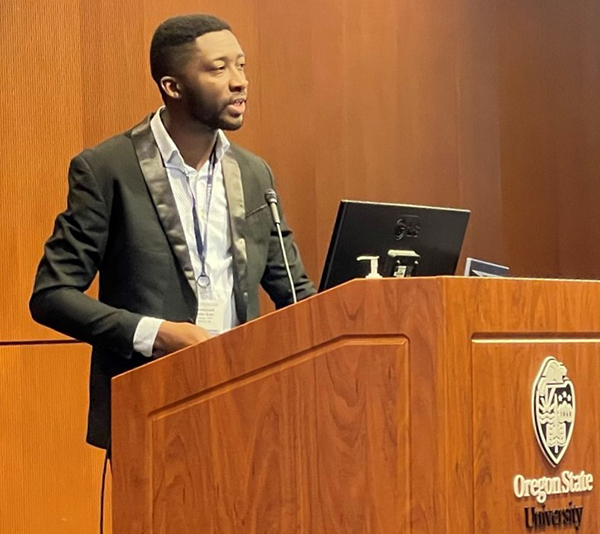
Emmanuel Mate-Kole explaining uncertainty in internal doses for consequence management
Photo courtesy of Dan Strom
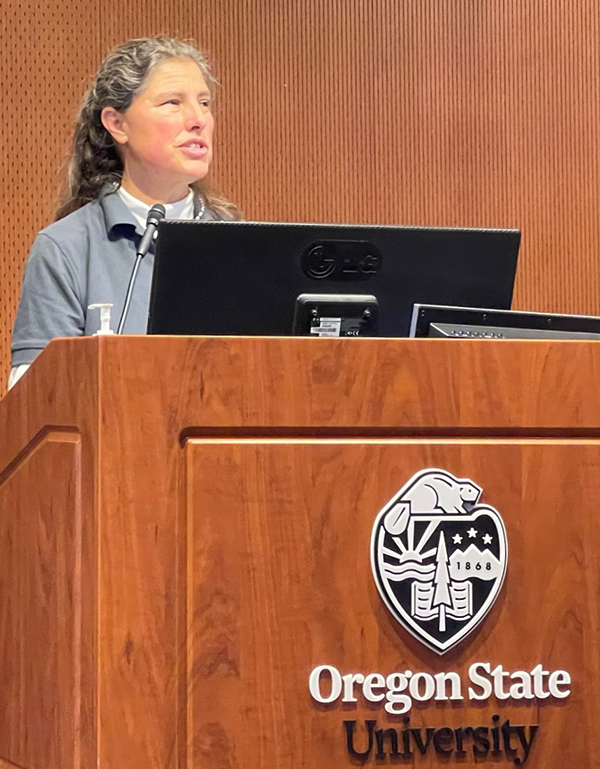
Cheryl Antonio during the tabletop exercise
Photo courtesy of Dan Strom
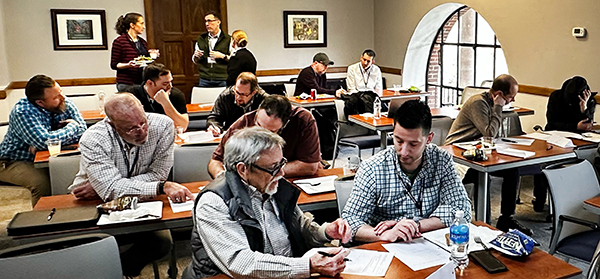
HPS Mentorship Committee internal dosimetry problem-solving lunchtime activity
Photo courtesy of Kendall Berry
Internal dosimetry was the subject of the Health Physics Society (HPS) Winter Workshop held 5–9 February 2023 at Oregon State University's Memorial Union in Corvallis, Oregon. The spacious venue provided table seating for participants and a generally good setting for a hybrid meeting.
After three online-only Professional Enrichment Program (PEP) classes on Sunday, Monday kicked off with talks by experienced veterans of internal dosimetry like Gus Potter, Cheryl Antonio, and Mike Stabin, balanced by contributions by younger presenters like Majid Khalaf, Brett Rosenberg, Caleigh Samuels, Donovan Anderson, and Amber Harshman. Lots of wisdom was shared, including almost as many "don'ts" as "dos," pitfalls, and successes. "Did you decay-correct the data?" asked Stabin. "First aid first," reminded Rosenberg. "You may want to turn this intake into a science project," but keep your priorities straight. Several speakers told us "Dr. Google doesn't have all the answers." Dr. Stabin also described new phantoms at the RADAR website.
Monday afternoon's presentations on internal dose coefficients began with Nicole Martinez's introduction to computational internal dosimetry, followed by a new systemic model for radon, use of specific absorbed fractions, and uses of coefficients. Derek Jokisch, the new director of the Center for Radiation Protection Knowledge at Oak Ridge National Laboratory, cleared up some unspoken confusions, saying, "There is no uncertainty in dose coefficients because the dose to a reference individual is a fixed point estimate." I would add that there is no variability in a reference individual, so there is no uncertainty in dose coefficients. After Philip Fulmer's insights on the use of dose coefficients, the Environmental Protection Agency's David Stuenkel explained the calculations that are used in developing the new Radionuclide Cancer Risk Coefficients that will be published soon as Federal Guidance Report 16 (FGR 16). Finally, John Klumpp introduced us to KDEP and DEPDOSE codes that "integrate over the individual space-time path through the plume" to simulate and calculate intakes.
Tuesday morning's session was focused on the United States Transuranium and Uranium Registries' (USTUR) historical and continuing research. In the opening talk, George Tabatadze presented a brief history of the Registries and the highlights of current research. The USTUR's national and international collaborations were described by Nicole Martinez, Sara Dumit, and Martin Šefl. Focus shifted to Tony Riddell's update on the new TAURUS internal dosimetry software, ultimately intended to be a successor to the widely-used IMBA code. John Brockman described ICP-MS measurements (as an alternative to alpha spectroscopy), Ron Goans presented work on biomarkers of exposure in radium dial painters, and Xirui Liu gave a comparison of autopsy reports with death certificates. The morning was capped off with a description of the USTUR golden nugget offered by John Boice.
Tuesday afternoon's program covered internal dosimetry in medical practice with presentations by Misty Liverett, William Erwin, and Darrell Fisher. Besides technological breakthroughs like silicon photomultipliers (SiPMs) and avalanche photodiodes (APDs) improving image quality, we learned about "theranostic" procedures combining therapy and diagnosis imaging. Lots of software was introduced, including mirdcalc, which is free from www.mirdsoft.org.
We got to sleep in on Wednesday morning due to the cancellation of the first session and launched into current research with Dunstana Melo (nuclear fallout dose coefficients), Emmanuel Mate-Kole (uncertainty in consequence management), Josh Knowland (extravasation), Joshua Hargraves and Brockway Elmore II (biota phantoms), and MinSeok Park (iodine-131 whole body counting). Robert Hayes treated us to a comprehensive review of air monitoring for dose estimation, underscored by personal experience with the 2014 Waste Isolation Pilot Plant explosion, among others. One memorable moment was Dr. Hayes's challenge to imagine doing representative sampling of shifting campfire smoke.
Wednesday afternoon concluded with Joshua Hayes's presentation on dose magnitude estimation in emergencies and Cheryl Antonio's review of the 1976 Hanford americium accident.
Thursday brought risk communication to our attention with presentations by Emily Caffrey, Sara Dumit, and John Klumpp. Fear on the part of someone who may have experienced an intake is real and serious and must be acknowledged and dealt with. Practical advice on listening, relating, empathizing, and communicating was shared. Kendall Berry suggested that we must "acknowledge the fear."
The workshop ended with a tabletop exercise of dosimetry challenges following an accident, led by Cheryl Antonio and Lynda DeMartino, which elicited a lot of audience participation, both online and in person. And as Rosenberg reminded us, "Detection does not mean danger!"
The workshop provided valuable and fun interactions in the evenings with colleagues in attendance. And a real highlight was provided by Jess Joyce and the HPS Mentorship Committee, which organized lunchtime problem-solving exercises in which teams of two or three people got a chance to work together as a learning experience.
This reporter attended the HPS Internal Dosimetry Summer Schools in 1994 and 2002, and this workshop was a great continuation of that tradition. Those two events produced excellent proceedings to which I have referred many times. Is that tradition passé now? In any case, the program committee of Rachel Pope Nichols, Richard Adams, and Joshua Hayes is to be commended for a successful meeting! And last but not least, Brett Burk and his staff did a fabulous job coping with technology challenges and keeping us connected.




